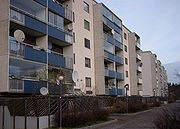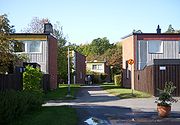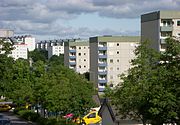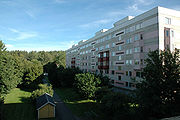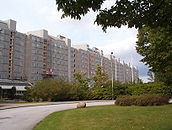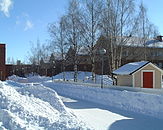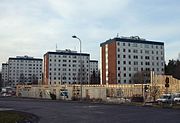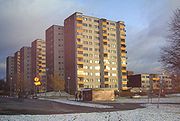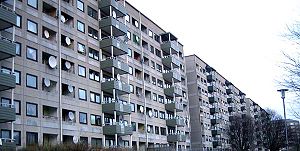- Million Programme
-
 Rebuilt Million Programme homes in Rinkeby (2009)
Rebuilt Million Programme homes in Rinkeby (2009)
The Million Programme (Swedish: Miljonprogrammet) is the common name for an ambitious housing programme implemented in Sweden between 1965 and 1974 by the governing Swedish Social Democratic Party to make sure everyone could have a home at a reasonable price. The aim of the programme was to build a million new dwellings in a 10-year period (hence the project's name). At the same time, a large proportion of the older unmodernised housing stock was demolished.
In the end, about 1,006,000 new dwellings were built. The net result was an increase in Sweden’s housing stock of 650,000 new apartments and houses, with a general rise in quality,[1] arguably at the expense of aesthetics.
Contents
Design
The new Million Programme residential areas were greatly inspired by early suburban neighbourhoods such as Vällingby and Årsta. One of the main aims behind the planning of these residential areas was to create "good democratic citizens". The means of achieving this were to build at high quality with a good range of services including schools, nurseries, churches, public spaces, libraries, and meeting places for different groups of households. A principal aim, although ultimately unsuccessful, was to mix and integrate different groups of households through the spatial mixing of tenures. Most of the apartments were of the "standard three room apartment" type (Swedish: normaltrea) of 75 m², planned for a model family of two adults and two children.
Common misconception
A common misconception of the Million Programme is that most (or all) of the residentials are tower blocks of concrete. In fact, the majority of the housing stock consists of apartment buildings with three or fewer floors, terraced houses and one-family houses.
Photos
Criticisms
While the programme did succeed in creating one million dwellings, many have criticised its execution and aftermath.
The most common complaint is that it created too many "ugly concrete buildings" which ruined the cityscape. Only 16% of the buildings actually used concrete on the exterior,[citation needed] and almost half the development was constructed as single-family homes, but the program is now popularly associated with the so called "concrete suburbs", i.e. dull, grey, low-status suburbs made mainly out of concrete slabs. The architecture in these areas is criticised for being sterile and some have even compared the buildings to those found in former Eastern Bloc countries called Panelák especially East Germany (Plattenbau). The three well-known suburbs Rinkeby (in Stockholm), Hammarkullen (in Gothenburg) and Rosengård (in Malmö) were all created as a part of the programme and have become symbols of the era. Many have complained about the fact that the Million Programme suburbs have been "taken over" by immigrants. In nearly all of the Million Programme suburbs the concentration of immigrants is very high. The most common complaints are about the high crime rate and the high racial and social segregation in the suburbs.
Million Programme districts
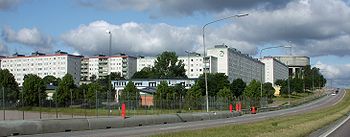 The suburb Tensta north of Stockholm
The suburb Tensta north of Stockholm
Well known Million Programme districts include:
- Rinkeby, Tensta and Husby in Stockholm
- Bredäng, Skärholmen and Vårberg in Stockholm
- Vårby gård, Masmo, Alby, Fittja and Hallunda in Botkyrka outside Stockholm
- Jordbro and Brandbergen in Haninge outside Stockholm
- Hallonbergen in Sundbyberg
- Hagalund in Solna
- Malmvägen in Sollentuna
- Hjällbo, Hammarkullen and several others in Angered outside Gothenburg
- Bergsjön and Kortedala outside Gothenburg
- Biskopsgården outside Gothenburg
- Hisings-Backa in Gothenburg
- Rosengård, Hermodsdal, Kroksbäck, Bellevuegården, Lorensborg, Lindängen, Höja and Holma in Malmö
- Kronogården in Trollhättan
- Kronoparken in Karlstad
- Ryd in Linköping
- Johannelund in Linköping
- Ekholmen in Linköping
- Berga in Linköping
- Skäggetorp in Linköping
- Gottsunda and Eriksberg in Uppsala
- Hertsön in Luleå
- Araby in Växjö
- Ålidhem in Umeå
- Mariehem in Umeå
- Årby in Eskilstuna
- Hässleholmen and Norrby in Borås
- Råslätt in Jönköping
- Ryd, Skövde in Skövde
- Hageby in Norrköping
- Navestad in Norrköping
- Ekön in Motala
- Norrliden in Kalmar
- Norra Fäladen and Klostergården in Lund
- Korsbacka in Kävlinge
- Skogslyckan and Dalaberg in Uddevalla
- Rosta in Örebro
- Andersberg in Gävle
Trivia
Several property owners and construction companies have committed to use virtual Minecraft constructs created by the swedish community, as a basis for reshaping of some of their projects. [2]
See also
References
Bulgarian: панелен блок (panelen blok), панелка (panelka) · Catalan: bloc prefabricat · Croatian: stambeni blok · Czech: Panelový dům, Panelák · German: Plattenbau · Estonian: Paneelmaja · Finnish: Elementtitalo · French: Maison à panneaux, HLM · Greek: προκατασκευασμένη οικία, often shortened to προκάτ (prokát) · Hungarian: panelház, often shortened to panel · Italian: Casa prefabbricata · Mongolian: Ugsarmal bair · Polish: Blok, Wielka płyta · Romania: Bloc · Russian: Панельный дом (Panelny dom) · Slovak: Panelový dom, Panelák · Serbian: Блок (Blok), pl. Блокови (Blokovi) · Spanish: Bloque prefabricado · Swedish: Miljonprogramhus · Ukrainian: Панельний будинок (Panelnyy budynok)Categories:- Political history of Sweden
- Housing in Sweden
- Modernism
Wikimedia Foundation. 2010.

